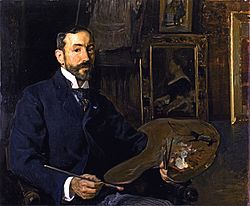José Moreno Carbonero
José Moreno Carbonero (born March 28, 1860 in Málaga , † April 15, 1942 in Madrid ) was a Spanish history painter .
Life
Moreno Carbonero was born in the Perchel district of Málaga. From 1868 he studied at the art school Escuela de Bellas Artes de Málaga in his hometown under José Denis Belgrano and Bernardo Ferrándiz . At the age of twelve he sold one of his paintings ("La Posada de la Corona") for 1,000 pesetas and at the age of 16 he won an art competition in his hometown. In 1874 he won the silver medal at a national exhibition and the bronze medal in 1876. In 1876 he received a scholarship from Marià Fortuny to study in Rome. After his return he won in 1881 with "El Príncipe de Viana" and in 1887 with "La Conversión del Duque de Gandía" at the national art exhibition.
In 1888, Entrada de Roger de Flor en Constantinopla ( Roger de Flors' arrival in Constantinople ) was another of his well-known pictures. From 1892 he taught at the Real Academia de Bellas Artes de San Fernando and also as a professor for naturalistic drawing at the Escuela Superior de Pintura, Escultura y Grabado in Madrid. In 1924 he was named "Hijo Predilecto de Andalucía" by the Andalusian government (German: honorary citizen ).
As a student at the academy in Madrid, the young Salvador Dalí trained intensively on the academic painting style of Moreno Carbonero. Already in Málaga, the young Pablo Picasso was influenced by the “School of Painting of Málaga”, which had formed around the newly founded Escuela de Arte de San Telmo de Málaga and to which Moreno Carbonero belonged. Picasso became his student in Madrid, and Juan Gris also attended his painting class.
After his death, his body was transferred to his hometown and buried there in the "Cementerio San Miguel" cemetery. Since 1958, a memorial made by Mariano Benlliure in the Instituto de Educación Secundaria Jardines de Puerta Oscura has commemorated him, and a street in the center of Málaga ( Calle Moreno Carbonero ) bears his name.
One of his most famous works is the oil painting “Segunda fundación de Buenos Aires” , 1910 (The second foundation of Buenos Aires), oil on canvas, 4 × 2.40 m, which is exhibited in the Museo Nacional de Bellas Artes in Buenos Aires .
Works

|
| El príncipe don Carlos de Viana |
|---|
| José Moreno Carbonero , 1881 |
| Oil on canvas |
| 310 × 242 cm |
| Prado, Madrid |
- La marquesa del Pazo de la Merced , 1906 ( Museo de Salamanca )
- Desembarco de Alhucemas , 1929 ( Alto Estado Mayor de Madrid)
- Doña Blanca de Navarra , ( Universidad de Santiago de Compostela )
- El vaso de agua , ( Spanish Consulate in París)
- La meta sudante , 1882 ( Museo Provincial de Bellas Artes de Málaga )
- La conversión del duque de Gandía , 1884
- Montero con perros
- El príncipe don Carlos de Viana , 1881
- Encuentro de Sancho Panza con el Rucio , 1876–1878 ( Museo de Bellas Artes de Sevilla )
- Don Quixote y los molinos de viento , ( Museo de Jaén )
- Don Álvaro Brake y Travesedo de la Cerda y Fernández Casariego, marqués de Villablanca, de cazador , 1929 (Museo de Jaén)
Web links
- Works by Moreno Carbonero on artnet.com
Individual evidence
- ↑ Some sources also give 1858 as the year of birth, but none of these sources give an exact date of birth.
- ↑ Source: Date of birth 1860 in the online edition of the Gran Enciclopèdia Catalana ( page no longer available , search in web archives ) Info: The link was automatically marked as defective. Please check the link according to the instructions and then remove this notice.
- ↑ Hijos Predilectos de Andalucía ( page no longer available , search in web archives ) Info: The link was automatically marked as defective. Please check the link according to the instructions and then remove this notice.
- ↑ Jacques Lassaigne, Spanish painting , Volume 2, Skira, 1952, p. 133 (available from Google Books)
- ^ Museu Picasso , Barcelona: website . Archived from the original on April 28, 2007.
- ↑ Conchi Quesada: Arte: Moreno Carbonero ( page no longer available , search in web archives ) Info: The link was automatically marked as defective. Please check the link according to the instructions and then remove this notice. (Spanish). P. 13.
- ↑ Ana María Fernández García, Catálogo de pintura española en Buenos Aires , Universidad de Oviedo, 1997, p. 129, ISBN 978-8-47468928-0 (available from Google Books)
| personal data | |
|---|---|
| SURNAME | Moreno Carbonero, José |
| BRIEF DESCRIPTION | Spanish painter |
| DATE OF BIRTH | March 28, 1860 |
| PLACE OF BIRTH | Málaga |
| DATE OF DEATH | April 15, 1942 |
| Place of death | Madrid |
